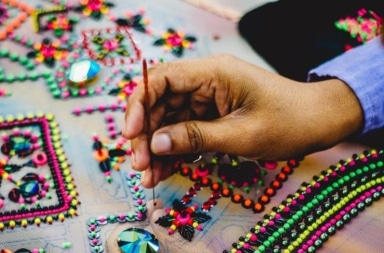There is very famous English saying that goes like “History is who we are and why we are the way we are”. This one line is enough to explain how important it is for us to hold on to our roots.
Since we are not the makers of history, history made us; it is important that we embrace what history has for us in its laps. Handmade items have always been the pride of India, and the uniqueness we add to every hand-made product is something incomparable.
The diversity and various cultures of India are evident in every aspect, and the craft of beautifying fabric is no exception. India has always been an artistic country and expressing with the help of art and craft has been in our blood for ages.
From the method of using the needle to the material used to fabricate, something is always new and changing in the various forms of embroidery, and the subject itself is full of surprises. There is an array of forms of embroidery that is popular all across India, below is a few of them which are loved and are an absolute favourite of the International designers. The Indian craft is sought after and loved all across the world in various forms, and one of those arts is the innumerable forms of embroidery. As India is made up of countless small cultures and states, every tradition has a different story to tell
- Zardozi
The term is derived from the Persian language and is made by joining two words, Zar and Dozi. Zar or Zari means Gold and Dozi which means Embroidery. Earlier this kind of embroidery was used by the Royal people to showcase their royalty and wealth.However, Zardozi patterns are confined to bridal wear these days because of its rich and heavy look. For cost-efficient outcomes, instead of using gold, people also use a fine metal thread of copper or silver.
Zardozi pattern can be made on fabrics like Heavy silk, satin, and velvet depending on the occasion. The fabricating of these embroideries is a long and intricate work which requires a lot of patience. So the next time you see a dress or fabric with Zardozi work on it, imagine the amount of hard-work and accuracy that is behind that beautiful outcome.
- Kashida
Ever swore by a Kashmiri shawl? Kashida embroidery is the one that made your heart flutter. This type of embroidery basically originated in the beautiful valleys of Kashmir, and the Kashmiris are making sure their tradition is taken forward by the world.Kashida is an intricate needlework technique that is required to trace reminiscent motifs like trees, birds, blossoms, and Chinars. These designs are typically displayed on Kashmiri Shawls, Pherans, rugs and stoles. The speciality of this kind of design is that it is typically done in a single-stitch manner.
- Gara
Created as a fusion of the Indian, Europeans, Chinese and the Persian cultures, Gara is a type of embroidery Parsi Women chose as their bridal wear.The types of motifs range from peacocks, roses, roosters, lotuses to dragons. This type of embroidery is a speciality of a Parsi culture and is loved by many International designers.
- Mirror-work
This kind of fabric work is a speciality of the Kutch and some of the Rajasthan regions. Interestingly, unlike most of the other embroideries, mirror-work is not confined to fabric beautification; rather it can be used in accessories and homewares as well.Mirrors of different sizes and shapes are used to create intriguing patterns. Also called Abhala Bharat Kaam or Shisha, this craft is one of the most exported artworks from India.
- Phulkari
This term is made by joining two terms, Phul and Kari. Phul means flowers and Kari stands for art. This form of embroidery originated in the fields of Punjab and the roots of it trace long back to the 18th Century.Phulkari even has a mention of it in the popular tales of Heer and Ranjha where Phulkari was an essential element of Heer’s attire. Many Indian, as well as International designers, derive inspiration from this embroidery and it is loved by everyone who has an eye for colourful motifs.
- Gota
The aboriginal of India, this craft is the most widely adopted both nationally and internationally. Arranged in an appliqué pattern, thin strips of gold and silver are displayed beautifully on Odhnis, Lehngas, and turbans.The motifs most commonly spotted are community traditions, local flora, and fauna. The designs earlier spotted were made with the help of precious metal, however, to make the embroidery cost-effective, these days the precious metals are replaced with silver strings coated with copper.
- Chikankari
The credit for the introduction of this embroidery to India goes to Noor Jahan who as the wife of Jahangir. Chikankari involves the stitching of yarn too fine fabrics typically white in colour.The base fabric is usually made up of muslin, voile or cotton. As a derivative, Chikankari is also done with colourful threads to give the fabric a brighter look.
- Sujini
An adaption for an ancient art form, Sujini is an embroidery technique performed by rural women in Bihar. Marked by a distinctive continuous stitch pattern, the term Sujini stands for storytelling.This kind of embroidery has also gained popularity mainly because of its contribution to the women empowerment. Instead of using flora and fauna as motifs, Sujini embroidery depicts social evils like domestic violence and dowry in its art.
This embroidery has played a major role in showcasing women’s aspirations in a patriarchal culture.
The art of decorating fabrics is not restricted to beautifying clothing but has also played a major role in expressing and empowering one’s wills and desires. Next time you come across a beautiful fabric with intricate embroidery, you will be able to infer the rich history and culture it is coming from.
























